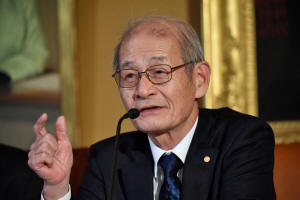Battery pioneer Akira Yoshino on Tesla, Apple and the electric future
 Send a link to a friend
Send a link to a friend
 [August 30, 2021]
By Paul Lienert [August 30, 2021]
By Paul Lienert
(Reuters) - Akira Yoshino, a co-winner of
the 2019 Nobel Prize in chemistry for his work on lithium-ion batteries,
can take credit for the upheaval in both the automotive and technology
industries.
Lithium-ion batteries have provided the first serious competition in a
century to fossil fuels and combustion engines for transportation. Now
an honorary fellow at Asahi Kasei, the Japanese chemical firm where he
has worked for nearly 50 years, Yoshino sees more disruption ahead as
transportation and digital technology become one industry, sharing
lithium battery technology.
Yoshino spoke with Reuters about about the next generation of electric
vehicle batteries, the potential for shared autonomous electric vehicles
that can charge themselves, the prospects for hydrogen fuel cell
vehicles and the possibility that Apple could lead the convergence of
the automotive and information technology industries in future mobility.
Here is an edited transcript:
Reuters: What technical innovations — in design, in chemistry and
materials, even in processes — might keep lithium ion as the dominant EV
battery chemistry and for how much longer?
Yoshino: There are two major areas of innovation that would be the key.
One would be new cathode materials and anode materials. The second one
would be the system where the EV is used. In other words, how people
will be using the EVs, and how they charge them and discharge them.

Reuters: Are you speaking of people using electric vehicles in different
ways? That is, not owning vehicles, but paying per use, for instance,
through ride sharing?
Yoshino: Yes, I think the biggest potential is in sharing. If autonomous
electric vehicles can become practical, that will cause a huge change in
the way people use vehicles.
Reuters: How long before wireless charging of electric vehicle batteries
will become a reality, whether it's through the roadbed or solar panels
on the vehicle or some other means?
Yoshino: The basic technology for wireless charging is not a problem.
The problem is how to apply this in a practical system. There are two
possibilities. One is cars that are parked in a certain place where
wireless charging is available. The second one is while the car is
moving. It's probably not going to be on every road, but on certain
roads where this is available, that could be possible.
If you think of autonomous electric vehicles, the vehicles will know
when they need to charge and on their own just go to the charging
station. That kind of situation can be practical sooner than you think.
[to top of second column]
|

Chemistry Laureate Akira Yoshino speaks during a news conference at
The Royal Swedish Academy of Sciences in Stockholm, Sweden December
7, 2019. Jonas Ekstromer/TT News Agency/via REUTERS

Reuters: Toyota and Honda are selling small numbers
of fuel cell electric vehicles, but the hydrogen infrastructure to
support fuel cells seems like it's many years away.
Yoshino: With the fuel cell vehicle, there are challenges on the
technology and the costs, but you can overcome them. If you think
about the longer term, 2030 to 2050, autonomous shared vehicles are
going to come about. Hypothetically, an autonomous vehicle could be
run by a gasoline engine, it could be electric, it could be a fuel
cell. It doesn't matter what the power source is. But it needs to
replenish its energy somehow. If the vehicle can't do that
automatically without a human intervention, the system is kind of
meaningless. The same thing would be true for gasoline or hydrogen.
In that sense, the electric vehicle is the one that can replace its
energy automatically. If you think of the Roomba vacuum cleaner,
this goes around the room and it goes and recharges itself. If the
Roomba needed a person to come and "fill up the tank," nobody would
want to buy the Roomba.
Reuters: What else should we know about the future of mobility?
Yoshino: Right now, the auto industry is thinking about how to
invest in the future of mobility. At the same time, the IT industry
is also thinking about the future of mobility. Somewhere, sometime,
with the auto industry and the IT industry, there is going to be
some kind of convergence for the future of mobility.
Tesla has their own independent strategy. The one to look out for is
Apple. What will they do? I think they may announce something soon.
And what kind of car would they announce? What kind of battery? They
probably want to get in around 2025. If they do that, I think they
have to announce something by the end of this year. That's just my
own personal hypothesis.
(Reporting by Paul Lienert in Detroit; editing by Edward Tobin)
[© 2021 Thomson Reuters. All rights
reserved.] Copyright 2021 Reuters. All rights reserved. This material may not be published,
broadcast, rewritten or redistributed.
Thompson Reuters is solely responsible for this content.
 |